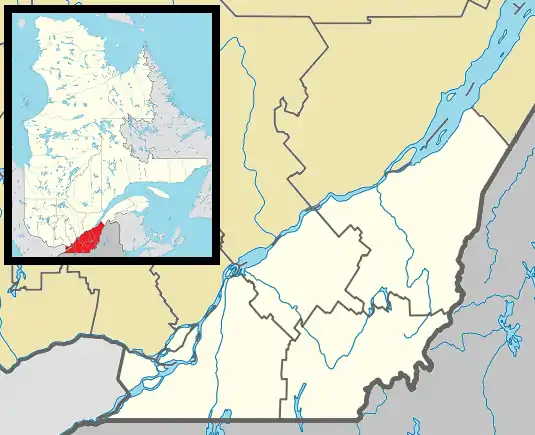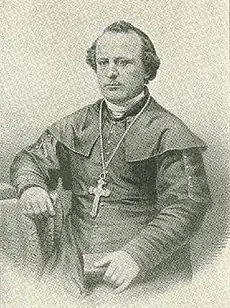Saint-Philippe, Quebec
Saint-Philippe (French pronunciation: [sɛ̃ filip]) is a city located in Roussillon Regional County Municipality in the Montérégie region of Quebec, Canada. It was established on July 1, 1855. The population as of the Canada 2021 Census was 7,597.
Saint-Philippe | |
|---|---|
City | |
 City of Saint-Philippe | |
 Location within Roussillon RCM | |
 Saint-Philippe Location in southern Quebec | |
| Coordinates: 45°21′N 73°28′W[1] | |
| Country | Canada |
| Province | Quebec |
| Region | Montérégie |
| RCM | Roussillon |
| Constituted | July 1, 1855 |
| Government | |
| • Mayor | Christian Marin |
| • Federal riding | La Prairie |
| • Prov. riding | La Prairie |
| Area | |
| • Total | 62.10 km2 (23.98 sq mi) |
| • Land | 61.96 km2 (23.92 sq mi) |
| Population (2021)[4] | |
| • Total | 7,597 |
| • Density | 122.6/km2 (318/sq mi) |
| • Pop 2016-2021 | |
| • Dwellings | 2,921 |
| Time zone | UTC−5 (EST) |
| • Summer (DST) | UTC−4 (EDT) |
| Postal code(s) | |
| Area code(s) | 450 and 579 |
| Highways | |
| Website | ville |
It's the birthplace of Pierre-Adolphe Pinsonnault, first Roman Catholic bishop of London.
History

The City of Saint-Philippe, officially constituted as a city in 2016, has origins that date back to the 17th century.
Originally, Saint-Philippe was part of the territory of the Seigneurie de La Prairie-de-la-Magdeleine, which covered the current territory of the municipalities of La Prairie, Brossard, Candiac, Sainte-Catherine and Saint -Philippe, as well as part of the territory of the municipalities of Saint-Lambert, Delson, Saint-Constant, Saint-Jean-sur-Richelieu and Saint-Jacques-le-Mineur. In 1647, the seigneury of La Prairie-de-la-Madeleine was granted by Jean de Lauzon to Abbé Jean de Laferté, a Jesuit and parish priest of La Madeleine in Paris. It was in 1667 that the first families settled.
In 1744, the first parish of Saint-Philippe, the Fabrique de la côte Saint-Philippe, was founded. It is following the cessation of eight arpents of land, in the Saint-Philippe coast of the Lordship of La Prairie-de-la-Magdeleine, by Sieur Louis Proveau and his wife Marianne Girou, and Dame Marie-Angélique Maheu, widow of the late Sieur Pierre François Girou, who allowed the construction of the first church. This was blessed in 1751, under the title of Saint-Jean-François-Régis, the patron saint of the Jesuits in the province of France. The second church of Saint-Philippe, the first built of stone, was blessed in 1782. This will contribute to the acceleration of the settlement of the small community. The second church was in place until the partial fire of January 1843 and the blessing of the rebuilt church took place at the end of the same year. Quickly becoming too small, a third church was built and blessed at the end of 1876. The new adjacent presbytery, which still exists today, was blessed in 1885.
On June 23, 1972, the neo-Gothic style church burned down. It was an extremely rare example of this architectural type. The inauguration of the new church, in 1973, of more modern architecture, contrasts with the old one.
The arrival of the 19th century brought its share of changes for Saint-Philippe. The successive legislative changes in Lower Canada have an impact on the status of the municipality, and this, on several occasions. The Municipality of the Parish of Saint-Philippe was created in 1845, under the leadership of Mr. Amable Coupal, the first mayor of Saint-Philippe.
Two years later, in 1847, following the adoption of the "Act to make better provisions for the establishment of municipal authorities in Lower Canada", the Municipality of the Parish of Saint-Philippe was abolished, thus becoming part of the county of Huntingdon.

It was not until 1855, following the adoption of the "Lower Canada Municipalities and Roads Act" that the municipality of the Parish of Saint-Philippe regained its name and status. It is this law that established the foundations of the municipal system in force today in Quebec. The first mayor of Saint-Philippe under this new regime was Mr. Joseph Normandin, who was also the son-in-law of Amable Coupal.
In 1841, by decree of canonical erection, the parish of Saint-Philippe is recognized on the religious level by specifying its boundaries. However, two other municipalities were created from the territory of Saint-Philippe, namely the municipality of Saint-Mathieu in 1917 and the City of Candiac in 1957.
The arrival of a major road infrastructure, Highway 15, in 1966 and a first section of Highway 30, comes to structure and define the space of the municipality.
On October 22, 2016, the Municipality, following a request to the Ministry of Municipal Affairs and Housing, changed its legislative regime and became subject to the Cities and Towns Act (CQLR, chapter C-19 ). At the same time, the Minister approves the change of name of the Municipality of Saint-Philippe to that of City of Saint-Philippe.
Demographics
| Year | Pop. | ±% |
|---|---|---|
| 1991 | 3,572 | — |
| 1996 | 3,656 | +2.4% |
| 2001 | 3,892 | +6.5% |
| 2006 | 5,121 | +31.6% |
| 2011 | 5,495 | +7.3% |
| 2016 | 6,320 | +15.0% |
| 2021 | 7,597 | +20.2% |
In the 2021 Census of Population conducted by Statistics Canada, Saint-Philippe had a population of 7,597 living in 2,856 of its 2,921 total private dwellings, a change of 20.2% from its 2016 population of 6,320. With a land area of 61.96 km2 (23.92 sq mi), it had a population density of 122.6/km2 (317.6/sq mi) in 2021.[6]
| 2021 | 2016 | 2011 | |
|---|---|---|---|
| Population | 7,597 (+20.2% from 2016) | 6,320 (+15.0% from 2011) | 5,495 (+7.3% from 2006) |
| Land area | 61.96 km2 (23.92 sq mi) | 61.95 km2 (23.92 sq mi) | 62.07 km2 (23.97 sq mi) |
| Population density | 122.6/km2 (318/sq mi) | 102.0/km2 (264/sq mi) | 88.5/km2 (229/sq mi) |
| Median age | 37.6 (M: 38, F: 37.6) | 38.6 (M: 38.6, F: 38.6) | 38.3 (M: 38.5, F: 38.1) |
| Private dwellings | 2,855 (total) | 2,627 (total) | 2,129 (total) |
| Median household income | $103,000 | $79,842 | $70,522 |
| Canada Census Mother Tongue - Saint-Philippe, Quebec[5] | ||||||||||||||||||
|---|---|---|---|---|---|---|---|---|---|---|---|---|---|---|---|---|---|---|
| Census | Total | French |
English |
French & English |
Other | |||||||||||||
| Year | Responses | Count | Trend | Pop % | Count | Trend | Pop % | Count | Trend | Pop % | Count | Trend | Pop % | |||||
2021 |
7,595 |
6,605 | 87.0% | 270 | 3.6% | 120 | 1.6% | 520 | 6.8% | |||||||||
2016 |
6,320 |
5,830 | 92.2% | 205 | 3.2% | 60 | 0.9% | 195 | 3.1% | |||||||||
2011 |
5,480 |
5,125 | 93.5% | 175 | 3.2% | 55 | 1.0% | 125 | 2.3% | |||||||||
2006 |
5,115 |
4,855 | 94.9% | 185 | 3.6% | 40 | 0.8% | 35 | 0.7% | |||||||||
2001 |
3,875 |
3,685 | 95.1% | 105 | 2.7% | 10 | 0.3% | 75 | 1.9% | |||||||||
1996 |
3,640 |
3,495 | n/a | 96.0% | 95 | n/a | 2.6% | 35 | n/a | 1.0% | 15 | n/a | 0.4% | |||||
Education
Centre de services scolaire des Grandes-Seigneuries is the French school board.
- École secondaire Fernand-Seguin in Candiac
- École primaire des Moussaillons-et-de-la-Traversée (Saint-Philippe) [12]
- pavillon de la Traversée
- pavillon des Moussaillons
Riverside School Board serves as the English school board.[13]
- St. Lawrence Elementary School in Candiac[14]
- Heritage Regional High School in Longueuil[15]
Transportation
The CIT Le Richelain provides commuter and local bus services.
Attractions
The Élodie-P.-Babin Complex is home to the Recreation, Culture and Community Life Department, the "Le Vaisseau d'Or" library, the Café Liberté 50 and Maison des jeunes organizations. It also hosts various recognized organizations for holding their regular activities.
See also
References
- "Reference number 319343 in Banque de noms de lieux du Québec". toponymie.gouv.qc.ca (in French). Commission de toponymie du Québec.
- Ministère des Affaires municipales, des Régions et de l'Occupation du territoire: Saint-Philippe
- Riding history for Brossard--La Prairie (Quebec) from the Library of Parliament
- 2021 Statistics Canada Census Profile: Saint-Philippe, Quebec
- Statistics Canada: 1996, 2001, 2006, 2011, 2016, 2021 census
- "Population and dwelling counts: Canada, provinces and territories, and census subdivisions (municipalities), Quebec". Statistics Canada. February 9, 2022. Retrieved August 29, 2022.
- "2021 Community Profiles". 2021 Canadian Census. Statistics Canada. February 4, 2022. Retrieved 2022-08-22.
- "2016 Community Profiles". 2016 Canadian Census. Statistics Canada. August 12, 2021. Retrieved 2022-04-29.
- "2011 Community Profiles". 2011 Canadian Census. Statistics Canada. March 21, 2019. Retrieved 2014-02-18.
- "2006 Community Profiles". 2006 Canadian Census. Statistics Canada. August 20, 2019.
- "2001 Community Profiles". 2001 Canadian Census. Statistics Canada. July 18, 2021.
- https://moussaillons.cssdgs.gouv.qc.ca/
- https://www.rsb.qc.ca/
- "St. Lawrence School".
- "Heritage Regional High School".